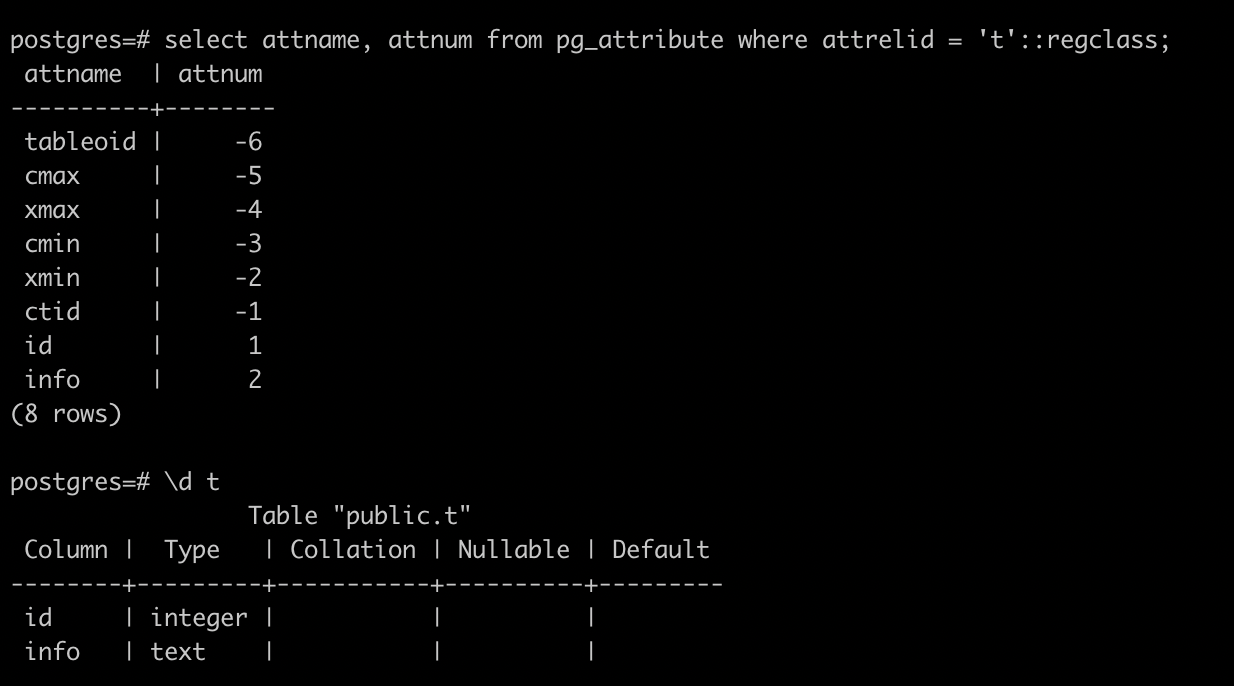PostgreSQL 系统属性添加
PostgreSQL 在插入数据的时候除了维护用户的属性列外,还有几个隐藏的系统属性列,如 ctid、xmin 和 xmax 等。如下图所示:

从上图中我们可以看到,系统属性列其编号(即 attnum )为负数,而用户自定义的属性列其编号则为正数(由 1 开始)。本文将介绍如何在 PostgreSQL 中添加自定义系统属性。
属性列
PostgreSQL 为每个属性列都在系统表 pg_attribute 中记录了一个元组,见官网文档。这里我们需要对几个常见的列有所认识,这也是本文后续要使用到的。
| 属性列 | 说明 |
|---|---|
| attname | 属性列的名称。 |
| atttypid | 属性列的数据类型的 OID,引用 pg_type 表的 oid 字段(外键约束)。 |
| attlen | 此属性列的数据类型长度,pg_type 表的 typlen 字段的副本。 |
| attnum | 属性列编号数。用户定义的普通属性列的编号从 1 开始。系统属性列列(例如 ctid)则为负数。 |
| attcacheoff | 存储中始终为 -1,但是当加载到内存中的行描述符时,可能会更新该行描述符以缓存行中属性的偏移量。 |
| atttypmod | 记录在创建表时提供的特定于类型的数据(例如,varchar 类型的最大长度)。它被传递给特定类型的输入函数和长度强制函数。对于不需要 atttypmod 的类型,该值通常为 -1。 |
| attbyval | 数据类型是否按值传递,pg_type 表的 typbyval 字段的副本。 |
| attstorage | 通常是此列类型的 pg_type 表的 typstorage 字段的副本。对于 TOAST-able 数据类型,可以在创建列后更改此值以控制存储策略。 |
| attalign | 数据类型的对其方式,pg_type 表的 typalign 的副本。c 表示按照 char 类型对齐(即不需要对齐);s 按 short 类型对齐(在大多数机器上是 2 字节对齐);i 表示按照 int 类型对齐(通常是 4 字节对齐);d 表示按照 double 类型对齐(通常是 8 字节对齐,但并不全是)。 |
| attnotnull | 该属性列是否具有非空约束。 |
| attislocal | 该属性列在表中是本地定义。请注意,属性列可以是本地定义并同时继承。 |
其实整个属性列都是通过 FormData_pg_attribute 结果来记录的,它定义在 src/include/catalog/pg_attribute.h 头文件中。
系统属性
PostgreSQL 的系统属性是在 src/backend/catalog/heap.c 源文件中定义的,如下所示:
1 | static const FormData_pg_attribute a1 = { |
从上面可以看到,属性列的编号是通过宏来定义的,例如 TableOidAttributenumber,这些宏的定义在 src/include/access/sysattr.h 头文件中定义,如下所示:
1 | /* |
atttypid 则是在 src/include/catalog/pg_type.dat 文件中声明,并在编译时由 perl 转换为 pg_type_d.h 文件中的宏定义。
最终这些系统属性列将被保存在 SysAttr 全局数组中。用户在建立表时,PostgreSQL 通过 AddNewAttributeTuples 函数向 pg_attribute 插入属性列信息,随后在加入系统属性信息,如下所示:
1 | for (i = 0; i < natts; i++) |
创建系统属性列
现在,我们对系统属性列的工作方式有所了解了,接下来就可以创建自定义系统属性列。首先我们声明一个属性列的编号,如下所示:
1 |
注意; 不要忘记更新 FirstLowInvalidHeapAttributeNumber 的值。
接着,我们需要声明属性列,并将其添加到 SysAtt 数组中,如下所示:
1 | static const FormData_pg_attribute a7 = { |
此时,我们就基本完成了属性列的添加。当然,为了能够查询,我还需要在两个地方做修改,它们均位于 src/backend/access/common/heaptuple.c 文件中。首先在函数 heap_attisnull 中增加我们的属性列:
1 | bool |
接着,在 heap_getsysattr 函数中添加如何获取 infomask 的值,如下所示:
1 | Datum |
最后,编译、初始化并启动数据库,效果如下图所示:

参考
[1] https://www.postgresql.org/docs/12/catalog-pg-attribute.html
[2] https://www.postgresql.org/docs/12/catalog-pg-type.html